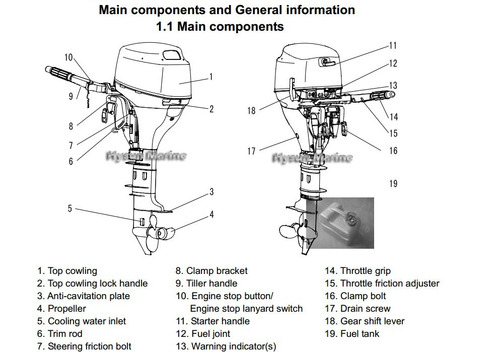|
Contact Details Sales Manager:. Terry:+86-189-5377-5187 Email:Terry@hysunmarine.com ISUP Sales:. David:+86-138-6319-2821 Email:Sales@hysunmarine.com |
Q31.How to fix cavitation in inflatable boat or dinghy?Q31.How to fix cavitation in inflatable boat or dinghy? A31.There are 4 major reasons for cavitation problems.Before checking, you should know the main components of an outboards engine.Please check the drawing as follow,
First, is an incorrect or damaged propeller. The second, and most likely, is that the boat is not fully or properly inflated. If the boat's chambers are not fully inflated, this will cause water disturbance under the boat tubes, and cavitations as a result. Please make sure that the boat is fully inflated by using hand pump. Do not use only electric pumps or compressors to inflate the boat. Use a hand air pump to pump up all boat chambers until they are hard to the touch. In general, once you feel that it becomes difficult to pump any more air with a hand pump, it means that the chamber is full. You can lightly knock with your hand on each compartment and it should feel hard, not soft. 3rd, and often overlooked reason for cavitation is seaweed and/or debris in a water stuck to outboard skegs or prop. Even a little bit of seaweed or piece of plastic bag stuck in small outboard can cause it to cavitate. Easiest fix for that is to put motor in a neutral, and clean debris around prop. Make sure prop is not rotating. The most recent response from a customer who fixed cavitation by properly inflating his SD365 boat was: "Thanks, I did what you said and went out in the ocean today and my boat ran great, really moves with this Honda 20hp outboard." 4th, if you had checked the above 3 points. Please try to adjust the outboards angle on transom.Please testing from low speed to high.
More Info about Cavitation due to the outboard propeller: Ventilation occurs when surface air or exhaust gases are drawn into the propeller blades. The load on the propeller is reduced by the mixing of air or exhaust into the water steam causing over revving. Anti-ventilation Plate: A large plate cast into gear case housing directly above propeller. Helps reduce surface air from being pulled into the blades. Cavitation: The aeration (bubbling) and boiling effect of water caused by creation of a low pressure area. Generally caused by a solid shape (propeller blade) passing through the water, in such a position and speed, that a low pressure area is formed due to the inability to move through the water in nonresistant manner. An example is, a propeller blade that has a rough edge would not cut efficiently through the water, thus creating a low pressure area. If the pressure drops below the vapor pressure, a cavitation bubble will form in that region. These bubbles will collapse when they reach the higher pressure region of the blade. This causes a rapid change in pressure and can result in physical erosion. You may notice burns (erosion) at some area on the face of the blade.
|


